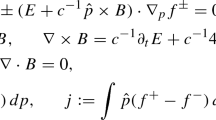Abstract
We report an exact solution of the Hartemann–Luhmann equation of motion for a charged particle interacting with an intense electromagnetic wave/pulse. It is found that the radiation reaction force has a significant affect on the charged particle dynamics and the particle shows, on average, a net energy gain over a period of time. Further, using a MATHEMATICA based single particle code, the net energy gained by the particle is compared with that obtained using Landau–Lifshitz and Ford–O’Connell equation of motion, for different polarizations of the electromagnetic wave. It is found that the average energy gain is independent of both the chosen model equation and polarization of the electromagnetic wave. Our results thus show that the simpler and hence analytically tractable Hartemann–Luhmann equation of motion (as compared to Landau–Lifshitz and Ford–O’Connell equation of motion) is adequate for calculations of practical use (for e.g. energy calculation).






Similar content being viewed by others
References
D.J. Griffiths, Introduction to Electrodynamics, 4th edn. (Pearson, Boston, 2013), re-published by Cambridge University Press in 2017. https://cds.cern.ch/record/1492149
J.D. Jackson, Classical Electrodynamics, 3rd edn. (Wiley, New York, 1999), ISBN 9780471309321, http://cdsweb.cern.ch/record/490457
Schott, Electromagnetic Radiation and the Mechanical Reactions Arising from it (University Press Cambridge, 1912)
M.R. Ferris, J. Gratus, J. Math. Phys. 52, 092902 (2011). https://doi.org/10.1063/1.3635377
H.A. Lorentz, The Theory of Electrons (Teubner, Leipzig, 1909)
M. Abraham, Theorie der Elektrizitat (Teubner, Leipzig, 1905)
P.A.M. Dirac, Proc. R. Soc. A 117, 610 (1928)
P.A.M. Dirac, Proc. R. Soc. A 172, 950 (1938)
H.J. Bhabha, Proc. R. Soc. A 117, 148 (1939)
J.A. Wheeler, R.P. Feynman, Rev. Mod. Phys. 17, 157 (1945)
F. Rohrlich, Phys. Rev. Lett. 12, 375 (1964)
C. Teitelboim, Phys. Rev. D 1, 1572 (1970)
A.O. Barut, Phys. Rev. D 10, 3335 (1974)
F. Rohrlich, Classical Charged Particles 3rd edn. (World Scientific, Syracuse University, New York, 2007)
C.S. Shen, Phys. Rev. Lett. 24, 410 (1970)
Y. Hadad, L. Labun, J. Rafelski, N. Elkina, C. Klier, H. Ruhl, Phys. Rev. D 82, 096012 (2010)
Y. Kravets, A. Noble, D. Jaroszynski, Phys. Rev. E 88, 011201 (2013)
V. Sagar, S. Sengupta, P.K. Kaw, Phys. Plasmas 22, 123102 (2015). https://doi.org/10.1063/1.4936797
X.L. Li, G.W. Ford, R.F. OConnell, Phys. Rev. A 42, 4519 (1990)
G. Ford, R. OConnell, Physics Letters A 157, 217 (1991)
G. Ford, R. OConnell, Physics Letters A 174, 182 (1993)
C.J. Eliezer, Proc. R. Soc. Lond. A 194, 543 (1948)
L.D. Landau, E.M. Lifshitz, The Classical Theory of Fields, 4th edn. (Butterworth-Heinemann, 1980), ISBN 0750627689, http://www.worldcat.org/isbn/0750627689
T. Mo, C. Papas, Phys. Rev. D 4(12), 3566–3571 (1971)
P. Caldirola, Riv. Nuovo Cimento Soc. Ital. Fis. 2, 1 (1979)
F.V. Hartemann, N.C. Luhmann, Phys. Rev. Lett. 74, 1107 (1995)
Y. Yaremko, J. Math. Phys. 54, 093115 (2013)
I.V. Sokolov, N.M. Naumova, J.A. Nees, G.A. Mourou, V.P. Yanovsky, Phys. Plasmas 16, 093115 (2009)
F. Rohrlich, Am. J. Phys. 68, 11099 ((2000))
F.V. Hartemann, High-Field Electrodynamics (CRC Press, Boca Raton, 2001)
C. Bild, D.A. Deckert, H. Ruhl, Phys. Rev. D 99, 096001 (2019)
P.K. Kaw, R.M. Kulsrud, Phys. Fluids 16, 321 (1973). https://aip.scitation.org/doi/pdf/10.1063/1.1694336
P. Gibbon, Short Pulse Laser Interaction with Matter (Imperial College Press, London, 2005)
See http://www.extreme-light-infrastructure.eu/ (2013). Accessed 4 Aug 2021
A.D. Piazza, Lett. Math. Phys. 83, 305 (2008)
H. Heintzmann, M. Grewing, Zeitschrift für Physik A Hadrons and nuclei 251, 77 (1972)
G. Lehmann, K.H. Spatschek, Phys. Rev. E 84, 046409 (2011)
R. Ondarza-Rovira, T.J.M. Boyd, IEEE Trans. Plasma Sci. 48, 685 (2020)
Y. Zhang, S. Krasheninnikov, Phys. Plasmas 26, 010702 (2019). https://doi.org/10.1063/1.5075720
Acknowledgements
We thank Dr. Sarveshwar Sharma for help with the numerical solution of the Hartemann–Luhmann equation and the anonymous referees for constructive suggestions.
Author information
Authors and Affiliations
Contributions
The problem was formulated by S.S and executed by S.K.M. Both S.K.M. and S.S. contributed to the final version of the paper.
Corresponding author
Analytical expressions for particle momentum and position
Analytical expressions for particle momentum and position
The integrals \({I}_{1}\), \(\mathbf {I}_{2}\) and expressions for momentum and position of a particle, starting from origin with zero initial momentum and interacting with an elliptically polarized electromagnetic wave train, are given by
Rights and permissions
About this article
Cite this article
Mishra, S.K., Sengupta, S. Exact solution of Hartemann–Luhmann equation of motion for a charged particle interacting with an intense electromagnetic wave/pulse . Eur. Phys. J. Spec. Top. 230, 4165–4174 (2021). https://doi.org/10.1140/epjs/s11734-021-00260-4
Received:
Accepted:
Published:
Issue Date:
DOI: https://doi.org/10.1140/epjs/s11734-021-00260-4




